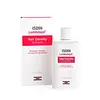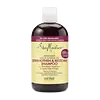What's inside
What's inside
 Key Ingredients
Key Ingredients

 Benefits
Benefits

 Concerns
Concerns

 Ingredients Side-by-side
Ingredients Side-by-side

Water
Skin ConditioningSodium Laureth Sulfate
CleansingDecyl Glucoside
CleansingCocamide DEA
EmulsifyingSodium Cocoamphoacetate
CleansingPEG-120 Methyl Glucose Dioleate
EmulsifyingPhenoxyethanol
PreservativeParfum
MaskingHexylene Glycol
EmulsifyingPolyquaternium-10
Sodium Benzoate
MaskingLaurdimonium Hydroxypropyl Hydrolyzed Wheat Protein
Silicone Quaternium-22
Alcohol
AntimicrobialCitric Acid
BufferingGlycerin
HumectantPyridoxine Hcl
Skin ConditioningPPG-3 Myristyl Ether
EmollientCoco-Glucoside
CleansingGlyceryl Oleate
EmollientSerenoa Serrulata Fruit Extract
Skin ConditioningPotassium Sorbate
PreservativeZinc PCA
HumectantArginine
MaskingAcetyl Tyrosine
Skin ConditioningSodium Carbonate
BufferingPEG-12 Dimethicone
Skin ConditioningCalcium Pantothenate
Zinc Gluconate
Skin ConditioningSodium Acetate
BufferingSodium Chloride
MaskingNiacinamide
SmoothingOrnithine Hcl
Skin ConditioningIsopropyl Alcohol
SolventPolyquaternium-11
Citrulline
Skin ConditioningHydrolyzed Soy Protein
HumectantGlucosamine Hcl
Disodium Succinate
MaskingArctium Majus Root Extract
Skin ConditioningTocopherol
AntioxidantPanax Ginseng Root Extract
EmollientBiotin
AntiseborrhoeicPentaerythrityl Tetra-Di-T-Butyl Hydroxyhydrocinnamate
AntioxidantHydrogenated Palm Glycerides Citrate
EmollientWater, Sodium Laureth Sulfate, Decyl Glucoside, Cocamide DEA, Sodium Cocoamphoacetate, PEG-120 Methyl Glucose Dioleate, Phenoxyethanol, Parfum, Hexylene Glycol, Polyquaternium-10, Sodium Benzoate, Laurdimonium Hydroxypropyl Hydrolyzed Wheat Protein, Silicone Quaternium-22, Alcohol, Citric Acid, Glycerin, Pyridoxine Hcl, PPG-3 Myristyl Ether, Coco-Glucoside, Glyceryl Oleate, Serenoa Serrulata Fruit Extract, Potassium Sorbate, Zinc PCA, Arginine, Acetyl Tyrosine, Sodium Carbonate, PEG-12 Dimethicone, Calcium Pantothenate, Zinc Gluconate, Sodium Acetate, Sodium Chloride, Niacinamide, Ornithine Hcl, Isopropyl Alcohol, Polyquaternium-11, Citrulline, Hydrolyzed Soy Protein, Glucosamine Hcl, Disodium Succinate, Arctium Majus Root Extract, Tocopherol, Panax Ginseng Root Extract, Biotin, Pentaerythrityl Tetra-Di-T-Butyl Hydroxyhydrocinnamate, Hydrogenated Palm Glycerides Citrate
Water
Skin ConditioningDecyl Glucoside
CleansingSodium Lauroyl Lactylate
EmulsifyingParfum
MaskingGlycerin
HumectantGuar Hydroxypropyltrimonium Chloride
Skin ConditioningPanthenol
Skin ConditioningHydrolyzed Rice Protein
Skin ConditioningButyrospermum Parkii Butter
Skin ConditioningRicinus Communis Seed Oil
MaskingMauritia Flexuosa Fruit Oil
Skin ConditioningNiacin
SmoothingHydrolyzed Wheat Protein
Skin ConditioningMentha Piperita Leaf Extract
Skin ConditioningAcetic Acid
BufferingYeast Extract
Skin ConditioningHydrolyzed Wheat Starch
Skin ConditioningHydrolyzed Keratin
HumectantGlycine Soja Oil
EmollientTocopherol
AntioxidantAloe Barbadensis Leaf Juice
Skin ConditioningTrifolium Pratense Flower Extract
AstringentCaramel
Cosmetic ColorantCaprylyl Glycol
EmollientCaprylhydroxamic Acid
Potassium Sorbate
PreservativeSodium Benzoate
MaskingWater, Decyl Glucoside, Sodium Lauroyl Lactylate, Parfum, Glycerin, Guar Hydroxypropyltrimonium Chloride, Panthenol, Hydrolyzed Rice Protein, Butyrospermum Parkii Butter, Ricinus Communis Seed Oil, Mauritia Flexuosa Fruit Oil, Niacin, Hydrolyzed Wheat Protein, Mentha Piperita Leaf Extract, Acetic Acid, Yeast Extract, Hydrolyzed Wheat Starch, Hydrolyzed Keratin, Glycine Soja Oil, Tocopherol, Aloe Barbadensis Leaf Juice, Trifolium Pratense Flower Extract, Caramel, Caprylyl Glycol, Caprylhydroxamic Acid, Potassium Sorbate, Sodium Benzoate
Ingredients Explained
These ingredients are found in both products.
Ingredients higher up in an ingredient list are typically present in a larger amount.
Decyl Glucoside is a glucose-based surfactant and emulsion stabilizer. It is created by reacting glucose with the fatty acids from plants.
Surfactants help clean the skin by trapping oil, sebum, and dirt to be washed away. As an emulsion stabilizer, it stabilizes the ingredients in a product by preventing them from separating.
This ingredient is biodegradable and non-toxic. This ingredient is commonly found in baby shampoos.
Decyl Glucoside is sometimes used to stabilize the UV filter Tinosorb.
Learn more about Decyl GlucosideGlycerin is already naturally found in your skin. It helps moisturize and protect your skin.
A study from 2016 found glycerin to be more effective as a humectant than AHAs and hyaluronic acid.
As a humectant, it helps the skin stay hydrated by pulling moisture to your skin. The low molecular weight of glycerin allows it to pull moisture into the deeper layers of your skin.
Hydrated skin improves your skin barrier; Your skin barrier helps protect against irritants and bacteria.
Glycerin has also been found to have antimicrobial and antiviral properties. Due to these properties, glycerin is often used in wound and burn treatments.
In cosmetics, glycerin is usually derived from plants such as soybean or palm. However, it can also be sourced from animals, such as tallow or animal fat.
This ingredient is organic, colorless, odorless, and non-toxic.
Glycerin is the name for this ingredient in American English. British English uses Glycerol/Glycerine.
Learn more about GlycerinParfum is a catch-all term for an ingredient or more that is used to give a scent to products.
Also called "fragrance", this ingredient can be a blend of hundreds of chemicals or plant oils. This means every product with "fragrance" or "parfum" in the ingredients list is a different mixture.
For instance, Habanolide is a proprietary trade name for a specific aroma chemical. When used as a fragrance ingredient in cosmetics, most aroma chemicals fall under the broad labeling category of “FRAGRANCE” or “PARFUM” according to EU and US regulations.
The term 'parfum' or 'fragrance' is not regulated in many countries. In many cases, it is up to the brand to define this term.
For instance, many brands choose to label themselves as "fragrance-free" because they are not using synthetic fragrances. However, their products may still contain ingredients such as essential oils that are considered a fragrance by INCI standards.
One example is Calendula flower extract. Calendula is an essential oil that still imparts a scent or 'fragrance'.
Depending on the blend, the ingredients in the mixture can cause allergies and sensitivities on the skin. Some ingredients that are known EU allergens include linalool and citronellol.
Parfum can also be used to mask or cover an unpleasant scent.
The bottom line is: not all fragrances/parfum/ingredients are created equally. If you are worried about fragrances, we recommend taking a closer look at an ingredient. And of course, we always recommend speaking with a professional.
Learn more about ParfumPotassium Sorbate is a preservative used to prevent yeast and mold in products. It is commonly found in both cosmetic and food products.
This ingredient comes from potassium salt derived from sorbic acid. Sorbic acid is a natural antibiotic and effective against fungus.
Both potassium sorbate and sorbic acid can be found in baked goods, cheeses, dried meats, dried fruit, ice cream, pickles, wine, yogurt, and more.
You'll often find this ingredient used with other preservatives.
Learn more about Potassium SorbateSodium Benzoate is a preservative. It's used in both cosmetic and food products to inhibit the growth of mold and bacteria. It is typically produced synthetically.
Both the US FDA and EU Health Committee have approved the use of sodium benzoate. In the US, levels of 0.1% (of the total product) are allowed.
Sodium benzoate works as a preservative by inhibiting the growth of bacteria inside of cells. It prevents the cell from fermenting a type of sugar using an enzyme called phosphofructokinase.
It is the salt of benzoic acid. Foods containing sodium benzoate include soda, salad dressings, condiments, fruit juices, wines, and snack foods.
Studies for using ascorbic acid and sodium benzoate in cosmetics are lacking, especially in skincare routines with multiple steps.
We always recommend speaking with a professional, such as a dermatologist, if you have any concerns.
Learn more about Sodium BenzoateTocopherol (also known as Vitamin E) is a common antioxidant used to help protect the skin from free-radicals and strengthen the skin barrier. It's also fat soluble - this means our skin is great at absorbing it.
Vitamin E also helps keep your natural skin lipids healthy. Your lipid skin barrier naturally consists of lipids, ceramides, and fatty acids. Vitamin E offers extra protection for your skin’s lipid barrier, keeping your skin healthy and nourished.
Another benefit is a bit of UV protection. Vitamin E helps reduce the damage caused by UVB rays. (It should not replace your sunscreen). Combining it with Vitamin C can decrease sunburned cells and hyperpigmentation after UV exposure.
You might have noticed Vitamin E + C often paired together. This is because it is great at stabilizing Vitamin C. Using the two together helps increase the effectiveness of both ingredients.
There are often claims that Vitamin E can reduce/prevent scarring, but these claims haven't been confirmed by scientific research.
Learn more about TocopherolWater. It's the most common cosmetic ingredient of all. You'll usually see it at the top of ingredient lists, meaning that it makes up the largest part of the product.
So why is it so popular? Water most often acts as a solvent - this means that it helps dissolve other ingredients into the formulation.
You'll also recognize water as that liquid we all need to stay alive. If you see this, drink a glass of water. Stay hydrated!
Learn more about Water